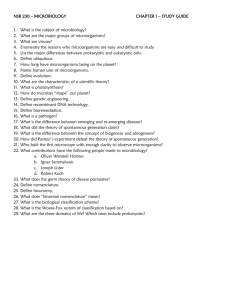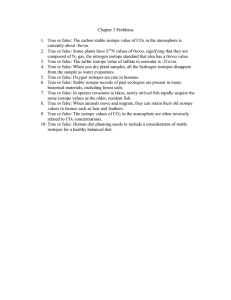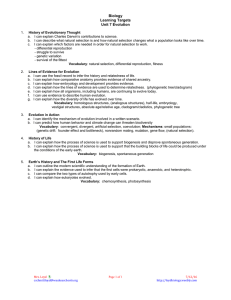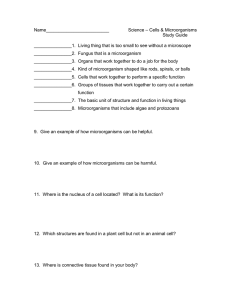MODERN BIOLOGY Learning Targets 1, 2. “HISTORY OF LIFE”
advertisement
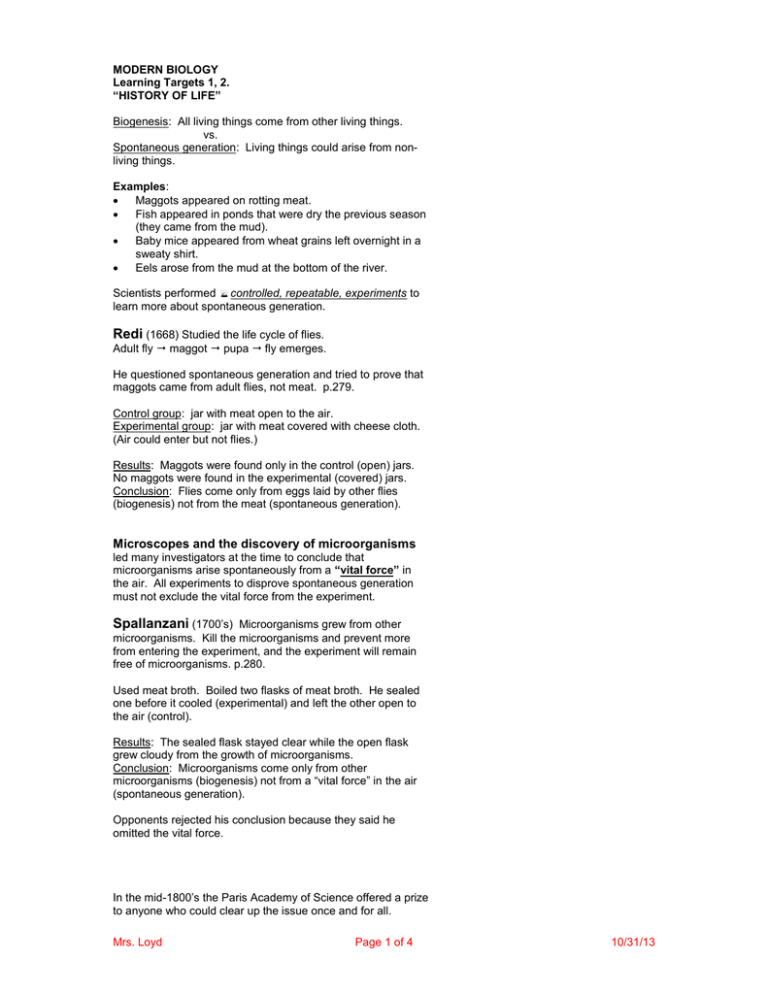
MODERN BIOLOGY Learning Targets 1, 2. “HISTORY OF LIFE” Biogenesis: All living things come from other living things. vs. Spontaneous generation: Living things could arise from nonliving things. Examples: Maggots appeared on rotting meat. Fish appeared in ponds that were dry the previous season (they came from the mud). Baby mice appeared from wheat grains left overnight in a sweaty shirt. Eels arose from the mud at the bottom of the river. Scientists performed controlled, repeatable, experiments to learn more about spontaneous generation. Redi (1668) Studied the life cycle of flies. Adult fly maggot pupa fly emerges. He questioned spontaneous generation and tried to prove that maggots came from adult flies, not meat. p.279. Control group: jar with meat open to the air. Experimental group: jar with meat covered with cheese cloth. (Air could enter but not flies.) Results: Maggots were found only in the control (open) jars. No maggots were found in the experimental (covered) jars. Conclusion: Flies come only from eggs laid by other flies (biogenesis) not from the meat (spontaneous generation). Microscopes and the discovery of microorganisms led many investigators at the time to conclude that microorganisms arise spontaneously from a “vital force” in the air. All experiments to disprove spontaneous generation must not exclude the vital force from the experiment. Spallanzani (1700’s) Microorganisms grew from other microorganisms. Kill the microorganisms and prevent more from entering the experiment, and the experiment will remain free of microorganisms. p.280. Used meat broth. Boiled two flasks of meat broth. He sealed one before it cooled (experimental) and left the other open to the air (control). Results: The sealed flask stayed clear while the open flask grew cloudy from the growth of microorganisms. Conclusion: Microorganisms come only from other microorganisms (biogenesis) not from a “vital force” in the air (spontaneous generation). Opponents rejected his conclusion because they said he omitted the vital force. In the mid-1800’s the Paris Academy of Science offered a prize to anyone who could clear up the issue once and for all. Mrs. Loyd Page 1 of 4 10/31/13 Pasteur’s Experiment Takes Prize! Pasteur’s experiment was very similar to Spallanzani’s with the exception of the equipment he used. Why did the swan-neck flask make such a difference? p.281 It allowed the vital force into the experiment but the U-shape of the neck trapped microorganisms preventing them from reaching the broth. Proponents of spontaneous generation gave up their fight. The principle of biogenesis became a cornerstone of biology. ? If spontaneous generation does not occur and the principle of biogenesis is true, how did the first living things on Earth form? Ch.14.2 Earth’s History The Formation of the Earth Use your notes from “Origins” Evolution of Life Heterotrophic Prokaryotes Graze on organic molecules Glycolysis & Fermentation: Requires no cell organelles. Occurs in cytoplasm. Photosynthetic Prokaryotes Photosynthesis: Cyanobacteria Archeabacteria First Eukaryotes (nucleus evolved first: many hypotheses): Endosymbiotic Theory 1. Mitochondria became animal cells 2. Chloroplasts (cyanobacteria engulfed by Euk. With mitochondria. Became plant cells. Chemistry Review: All atoms of the same element have the same # of protons and therefore the same atomic #. Atoms of the same element with differing numbers of neutrons are called isotopes. mass # = # of protons plus # of neutrons. isotope names: symbol plus mass # Example: H-1, H-2, H-3 (protium, deuterium, tritium) C-12, C-14 (say: carbon twelve, carbon fourteen) Rounding the atomic mass from the periodic table gives you the mass of the most common isotope in nature. (Atomic mass is the average of the mass of the isotopes in the ratio that they occur in nature.) Mrs. Loyd Page 2 of 4 10/31/13 Radioactive Isotopes: Some isotopes have unstable nuclei that undergo radioactive decay, that is, they release particles or radiant energy (radiation) or both, until the nuclei become stable. Rate of Decay or Half-life: length of time it takes for one-half of any size sample of an isotope to decay to a stable form. Each isotope has a definite rate but the rates vary from isotope to isotope. p.284 Isotope Carbon-14 Uranium-235 Potassium-40 Uranium-238 Half-life (years) 5,730 704 million 1,250 million 4,500 million Radiometric Dating (radioactive-dating, radiocarbon-dating) Used to determine the age of materials. Radioactive isotopes occur naturally in all matter. When an organism dies, its uptake of carbon stops, and decay of the existing carbon-14 continues. Thus, over time, the amount of carbon-14 declines with respect to the original amount of the stable carbon-12. After 5,730 years, half of the carbon-14 in a sample will have decayed. After another 5,730 years half of the remaining C-14decays and leaves only 25% of the original amount. Example: If a bone is found that contains 25% of the original amount of C-14 remaining, how old is it? (½ of a ½ = 25%) (number of times you said “½” = 2) or 2 half-lives How long is the half-life for C-14? = 5,730 years (chart) 2 half-lives x 5,730 years = 11,460 years old. Which isotope to use? Carbon-14 dating is limited to dating organic remains less than 60,000 years old. Which isotope from the chart above would you want to use to date the oldest rocks on Earth? Isotopes with short half-lives are most useful for dating relatively young rocks, while those with long half-lives are most useful for dating older rocks. Activity: Half-Life Lab First Organic Compounds (Haldane and Oparin’s Hypothesis) If the early earth had an atmosphere containing simple molecules life: ammonia, hydrogen gas, water vapor and compounds made of hydrogen and carbon like methane, how did those become more complex molecules like amino acids (the building blocks of proteins) and nucleotides (monomers of DNA, RNA)? Urey/Miller Experiment fig.14-6 p.285: starting with the above hypothesis, they set up an experiment to test it. It was a closed system and included a boiling chamber, electrodes to simulate lightening bursts, a condenser, and a U-fitting with a valve to extract samples without letting air in. Results: It produced a variety of organic compounds including amino acids (monomers of protein) Subsequent experiments produced ATP (energy shuttle) Nucleotides (monomers of nucleic acids) Conclusions: Basic organic compounds could have formed under the conditions of the early Earth. Mrs. Loyd Page 3 of 4 10/31/13 The atmospheric conditions using carbon dioxide and oxygen showed that both interfere with the production of organic compounds Therefore, formation of the first organic compounds may have occurred in areas protected from the atmosphere, such as those that exist in undersea hot springs. Meteorites may have introduced organic compounds from space. From Molecules to Cell-Like Structures TedTalks: Mark Hanczyc : Protocells http://www.ted.com/talks/martin_hanczyc_the_line_between_life_and_not_life?language=en - t-860819 Protocells (aka: Microspheres and coacervates) form spontaneously in the laboratory from solutions of simple organic chemical. have cell-like properties: Take up certain substances from their surroundings. can grow. can bud to form smaller microspheres. Do not have hereditary characteristics and do not respond to natural selection. This shows that some important aspects of cellular life can arise without direction from genes. The gap between the nonliving chemical compounds and cellular life may not be clear as once believed, but a continuum. The First Cells No direct evidence No oxygen gas Oldest cells are size and shape of prokaryotes developed in environment filled with organic molecules for food, “primordial soup” anaerobic, heterotrophic prokaryotes competition for limited food autotrophs would have big advantage Chemosynthesis (chemoautotroph) CO2 serves as a carbon source for organic molecules. Energy obtained from oxidation of inorganic substances (S) Example: modern Archaea: unicellular, harsh environs. Photosynthesis and Aerobic Respiration 3 bya photosynthesis began chemical traces of photosynthetic activity fossil stromatolites (blue-green algal colonies) Example: modern blue-green algae Accumulation of O2 as ozone, O3, took 1 b.y. Absorbed U.V. radiation allowing life to move to land. First Eukaryotes: created by evolution of a nucleus Endosymbiosis: small prokaryotes taken in by larger prokaryotes created membrane-bound organelles aerobic prokaryotes mitochondria photosynthetic prokaryotes chloroplasts mitochondria and chloroplasts contain own DNA. DNA is circular like prokaryotic DNA. Mrs. Loyd Page 4 of 4 10/31/13



